Visuals
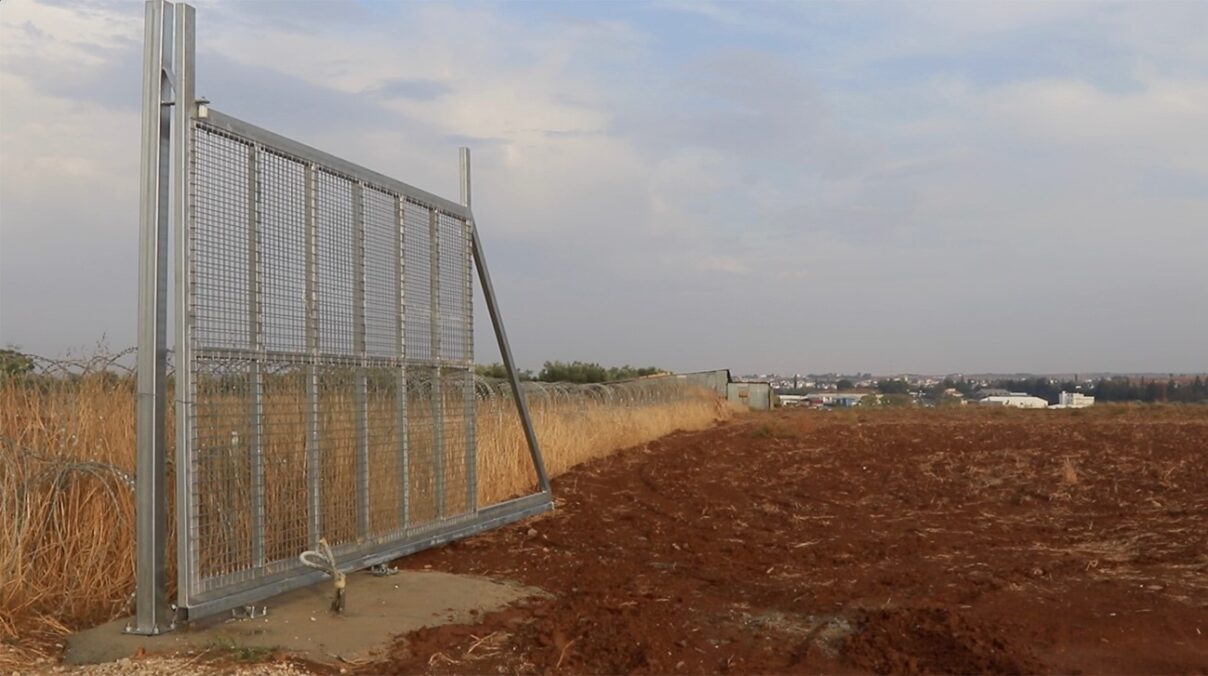 Metal gate in the Buffer Zone, Akaki village, Cyprus
Metal gate in the Buffer Zone, Akaki village, Cyprus
15 Oct. 2022, video still, © Efi Savvides
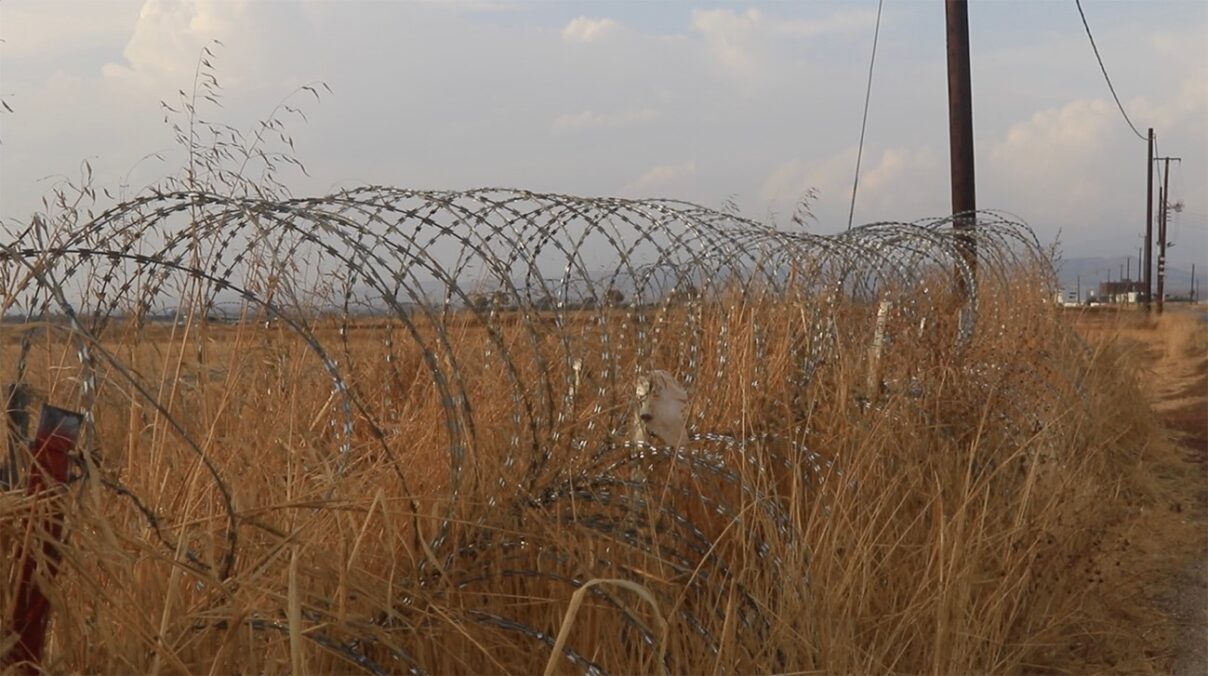 Barbed wire along the Buffer Zone, Akaki village, Cyprus
Barbed wire along the Buffer Zone, Akaki village, Cyprus
15 Oct. 2022, video still, © Efi Savvides
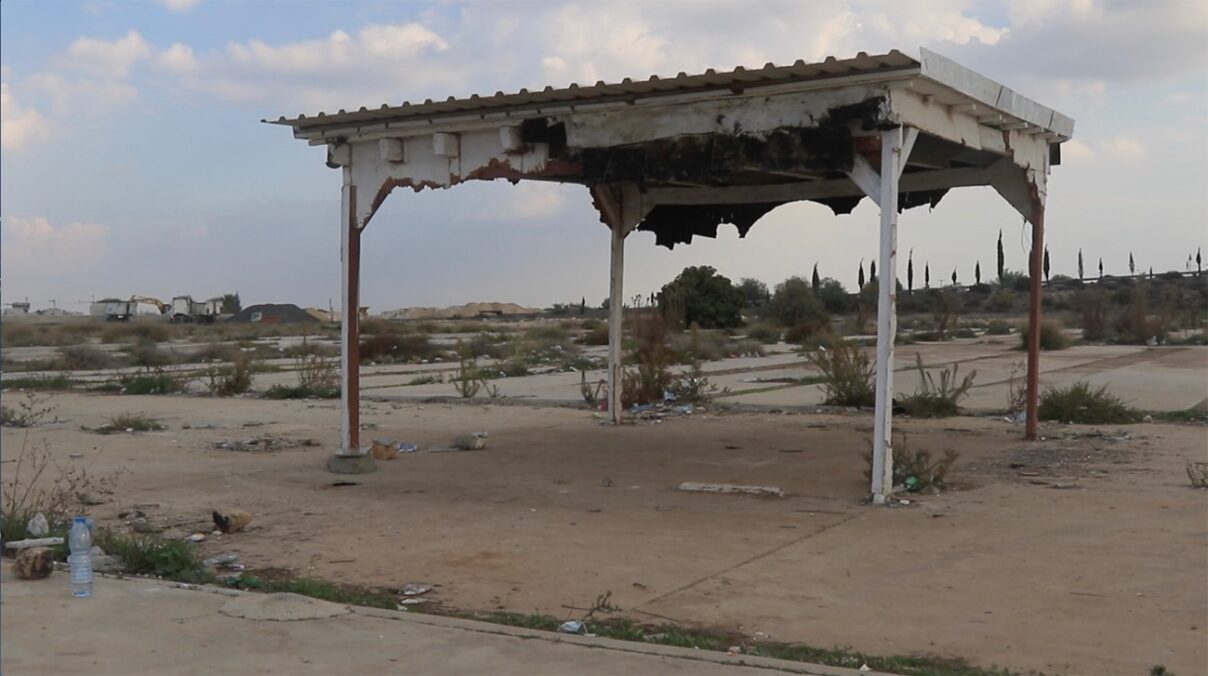 Bus Stop at Pournara First Reception Centre, Kokkinotrimithia, Cyprus
Bus Stop at Pournara First Reception Centre, Kokkinotrimithia, Cyprus
6 Dec. 2022, video still, © Efi Savvides
 Enosis [Union] of Nationalist Associations of Kokkinotrimithia (right-wing party)
Enosis [Union] of Nationalist Associations of Kokkinotrimithia (right-wing party)
23 Oct. 2022, video still, © Efi Savvides
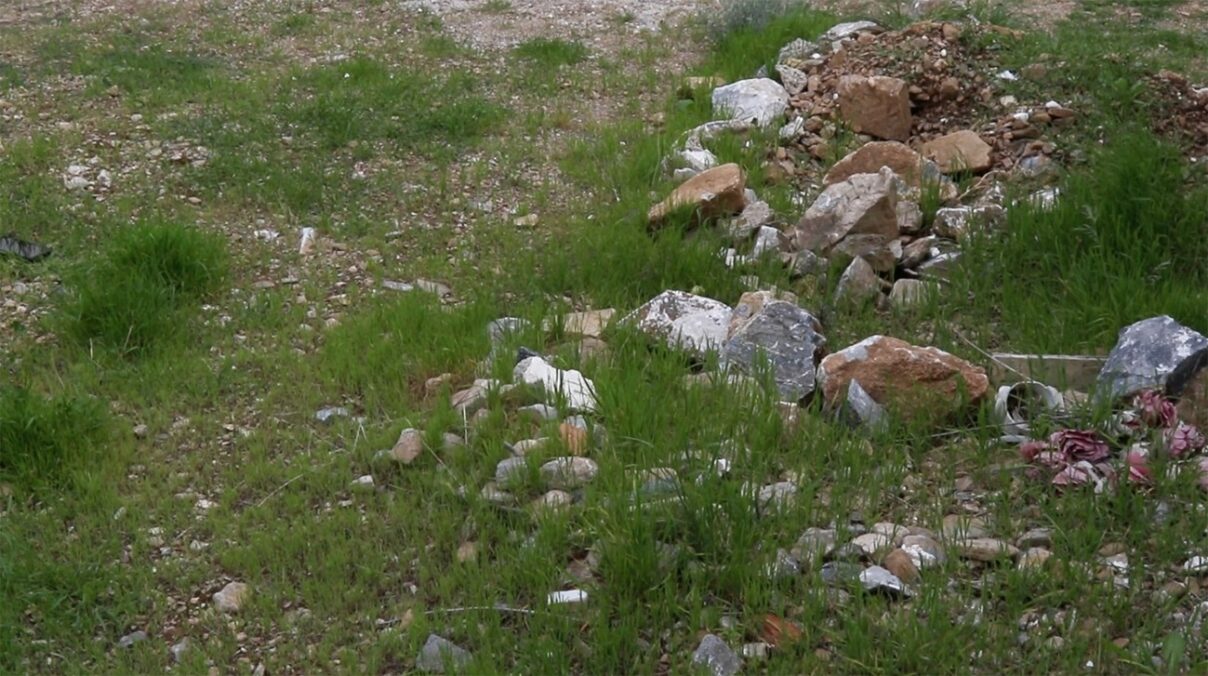 Grave of anonymous migrant, Vathy Cemetery, Samos
Grave of anonymous migrant, Vathy Cemetery, Samos
18 March 2023, video still, © Efi Savvides
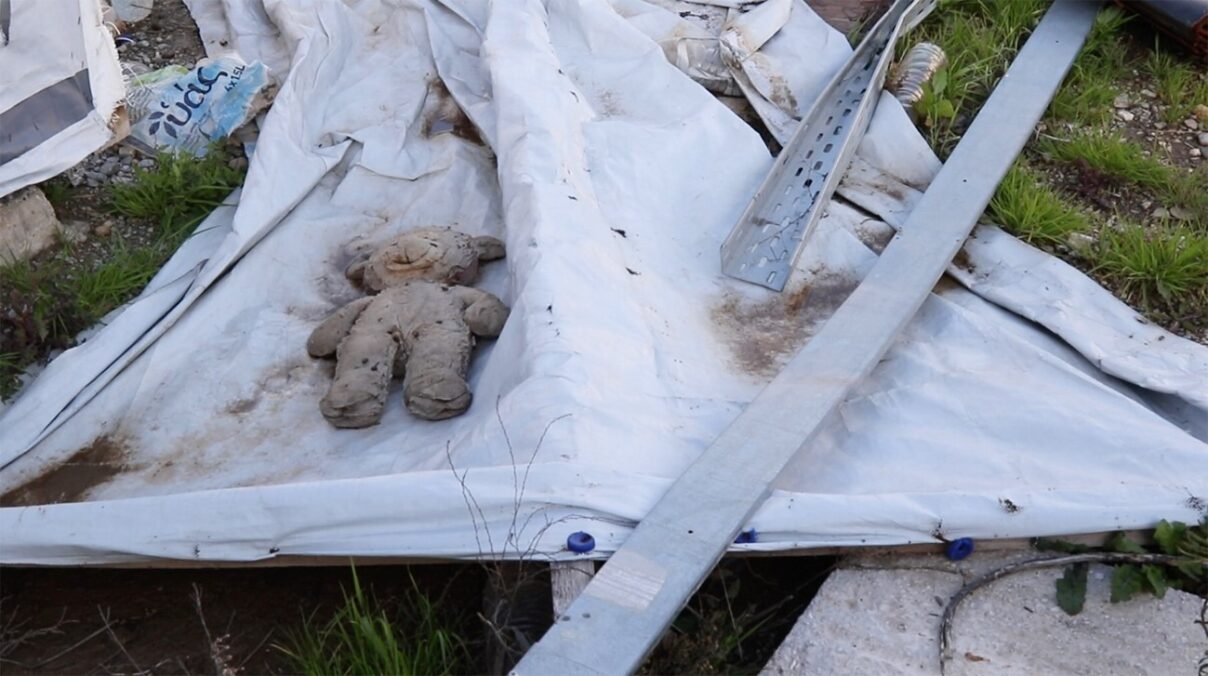 Vathy Old Reception and Identification Center, Samos
Vathy Old Reception and Identification Center, Samos
6 March 2023, video still, © Efi Savvides
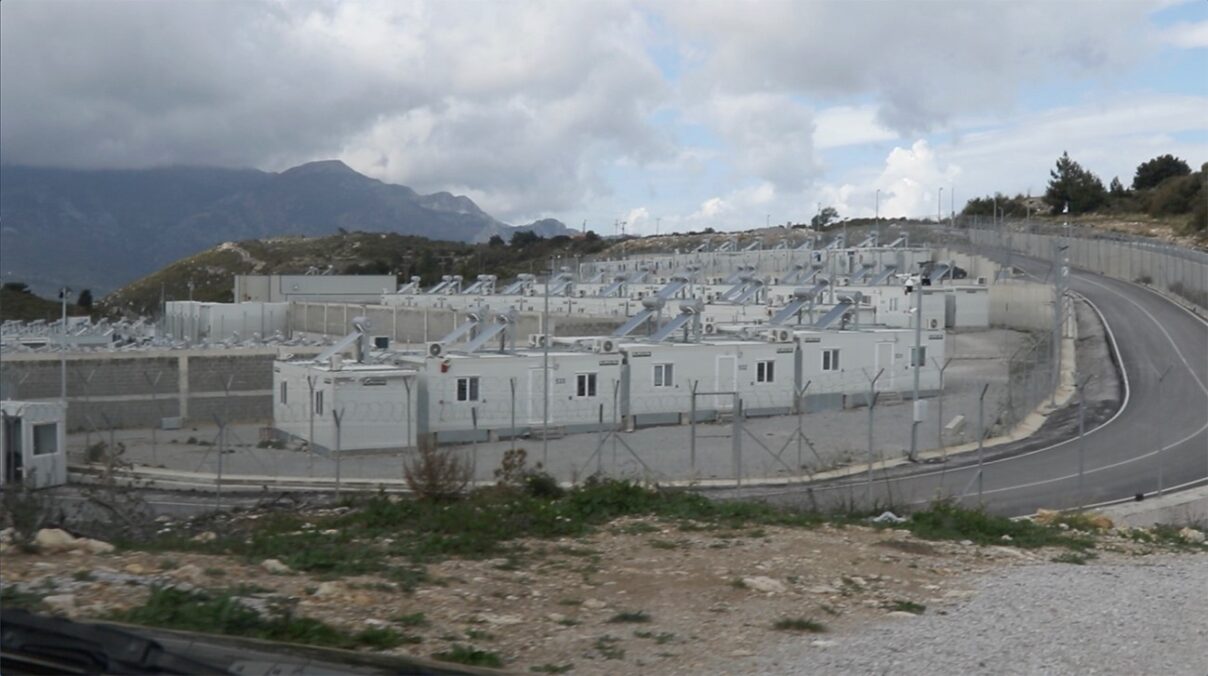 Zervou Multi-Purpose Reception and Identification Centre, Samos
Zervou Multi-Purpose Reception and Identification Centre, Samos
7 March, 2023, video still, © Efi Savvides
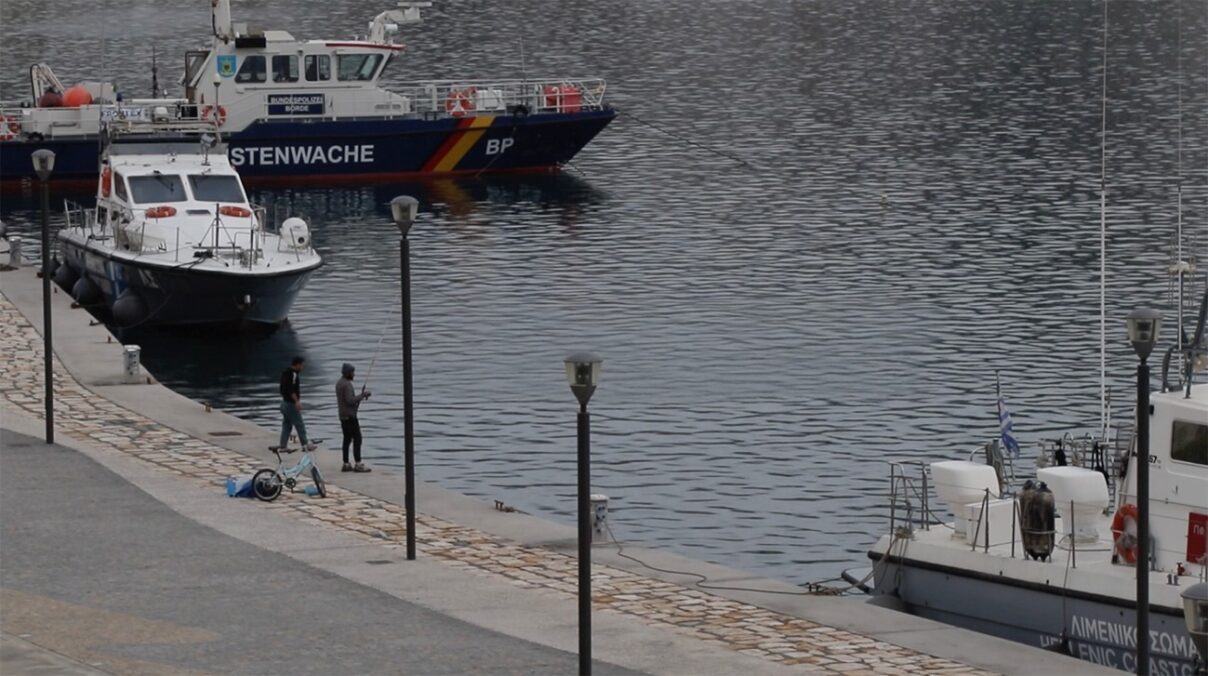 Vathy port, 2 Hellenic Coast Guard, Samos
Vathy port, 2 Hellenic Coast Guard, Samos
5 March, 2023, video still, © Efi Savvides
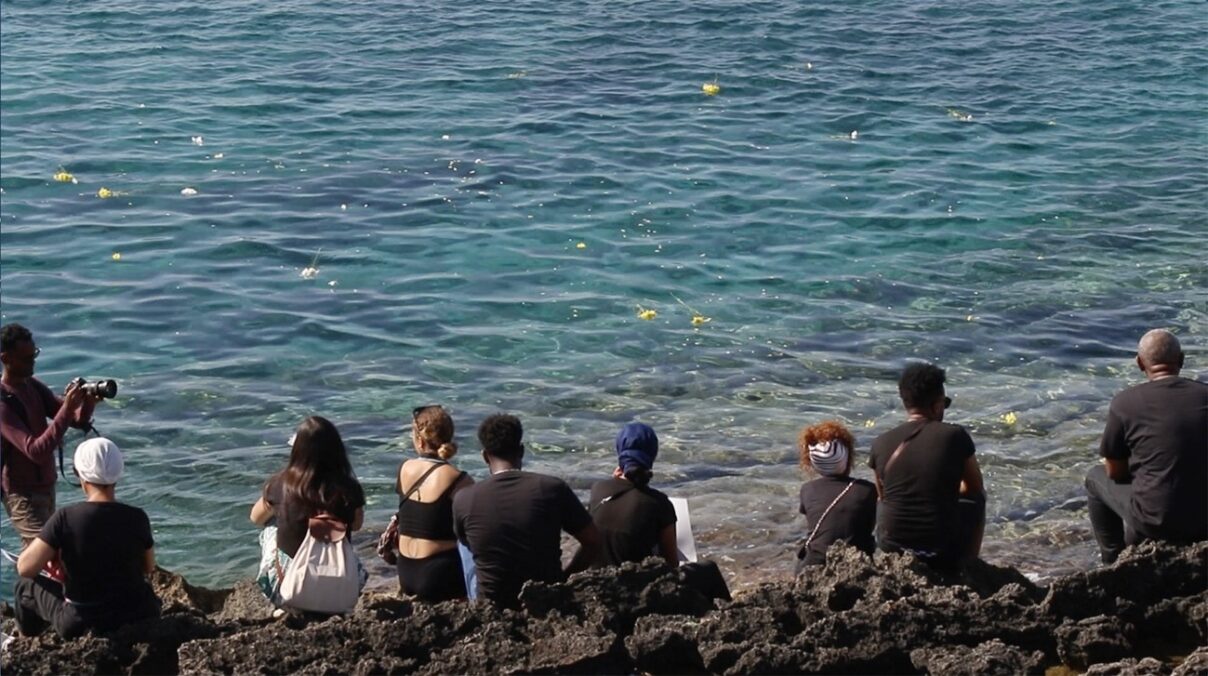 3rd October, 10-year anniversary in memory of the 368 migrants who died at sea in a shipwreck off Lampedusa coast, 3 Oct. 2023, video still, © Efi Savvides
3rd October, 10-year anniversary in memory of the 368 migrants who died at sea in a shipwreck off Lampedusa coast, 3 Oct. 2023, video still, © Efi Savvides
 Lampedusa Cemetery, grave of Youssef Ali Kanneh, b. 26 April 2020, Libya, died in the Mediterranean sea off Lampedusa coast on 11 Nov. 2020.
Lampedusa Cemetery, grave of Youssef Ali Kanneh, b. 26 April 2020, Libya, died in the Mediterranean sea off Lampedusa coast on 11 Nov. 2020.
5 Oct. 2023, video still, © Efi Savvides
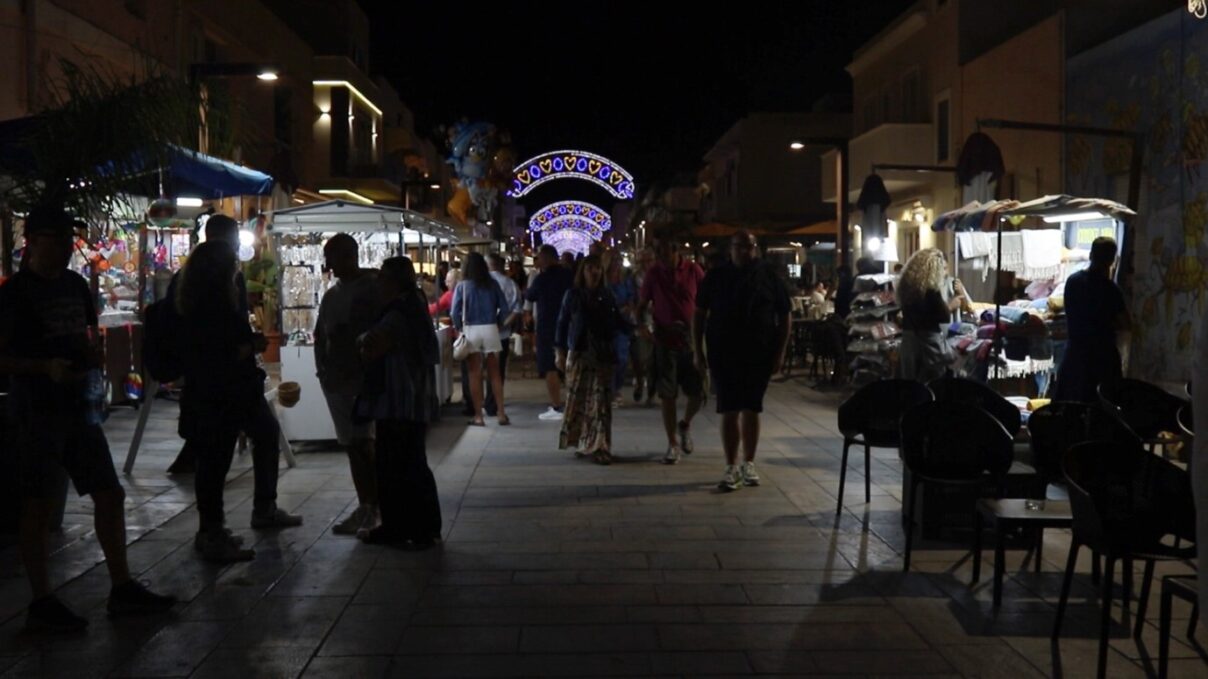 Via Roma by night, Lampedusa, 5 Oct. 2023, video still, © Efi Savvides
Via Roma by night, Lampedusa, 5 Oct. 2023, video still, © Efi Savvides
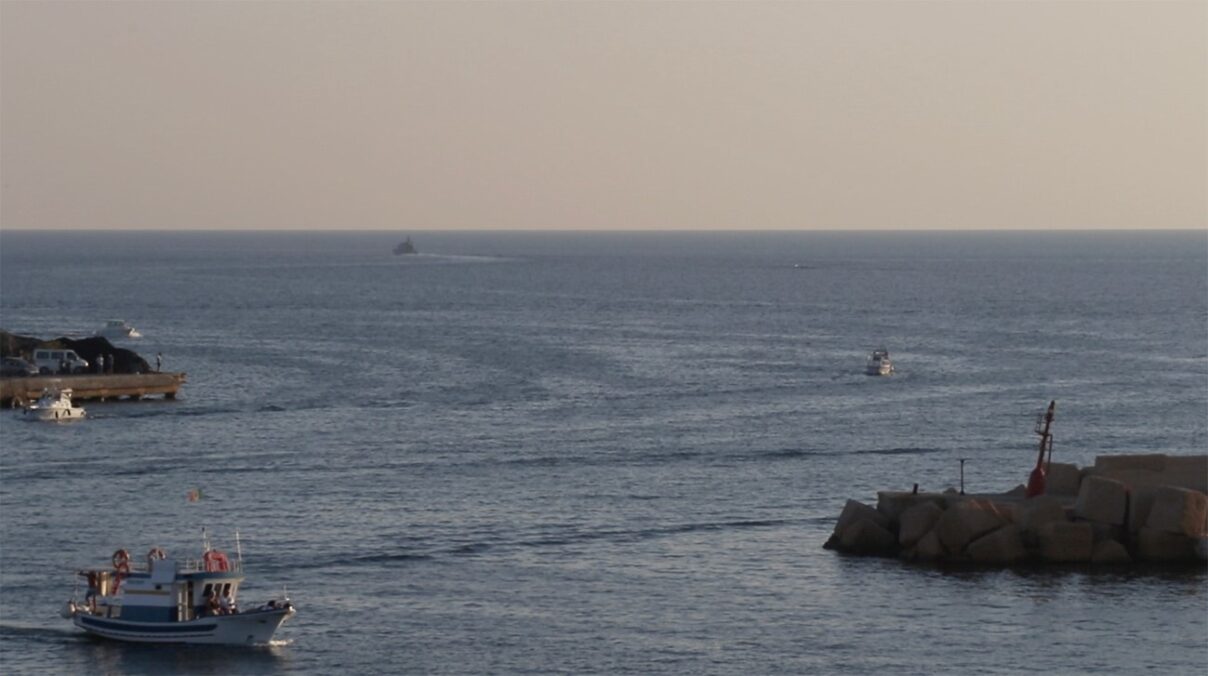 Nuovo Port, Lampedusa: the single point where migrants are likely to meet tourists
Nuovo Port, Lampedusa: the single point where migrants are likely to meet tourists
4 Oct. 2023, video still, © Efi Savvides
 Asylum seekers detained at first reception centre ‘Pournara’ looking through the double fence construction.
Asylum seekers detained at first reception centre ‘Pournara’ looking through the double fence construction.
29 Oct. 2023 © Maria Kenti-Kranidioti
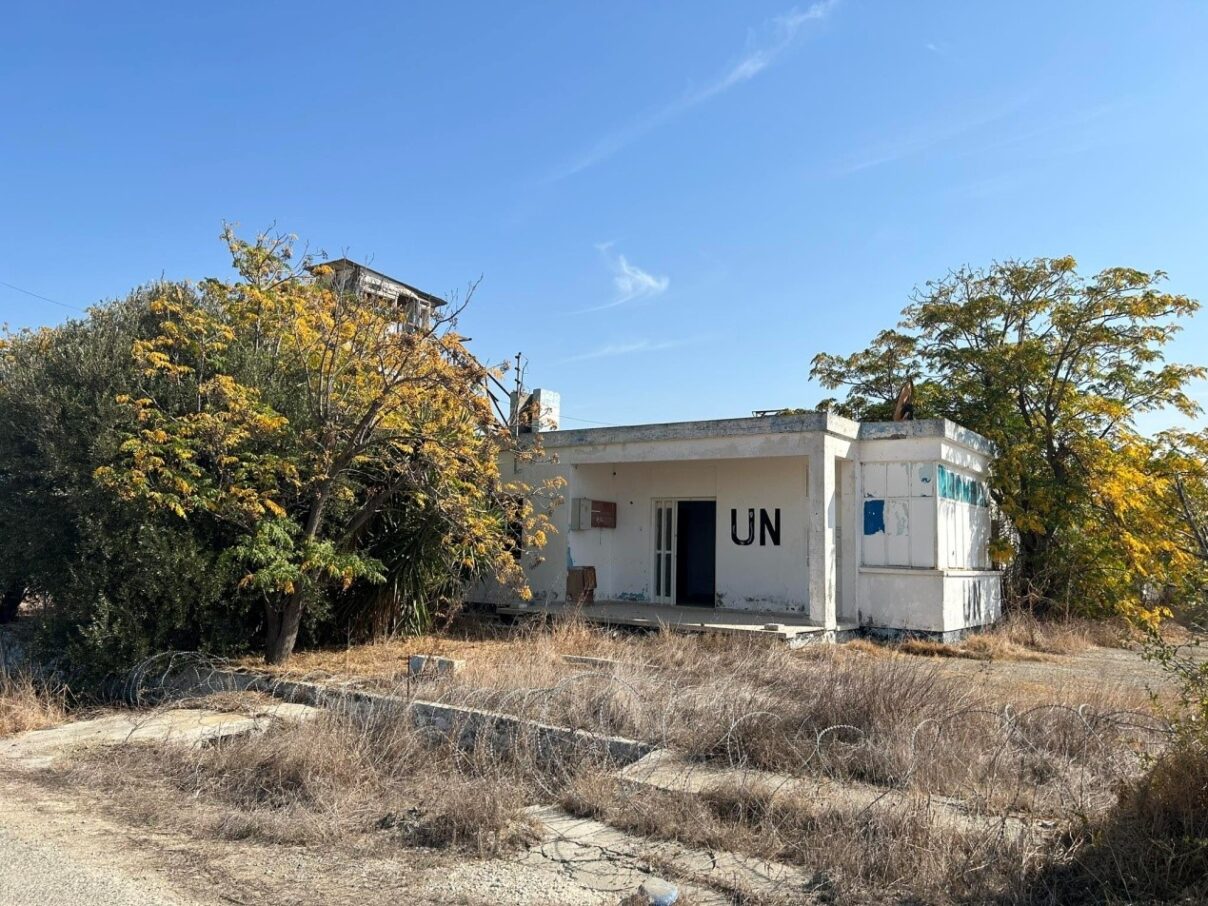 Abandoned UN post near the buffer zone outside the village of Deneia.
Abandoned UN post near the buffer zone outside the village of Deneia.
29 October © Maria Kenti-Kranidioti
 Curtailing migrant arrivals: Section of the 11km of barbed wire running across the UN buffer zone in the Akaki village area.
Curtailing migrant arrivals: Section of the 11km of barbed wire running across the UN buffer zone in the Akaki village area.
29 Oct. 2023 © Maria Kenti-Kranidioti
 Anti-Pournara protest outside Parliament in Nicosia on 7 July 2022.
Anti-Pournara protest outside Parliament in Nicosia on 7 July 2022.
© Maria Kenti-Kranidioti
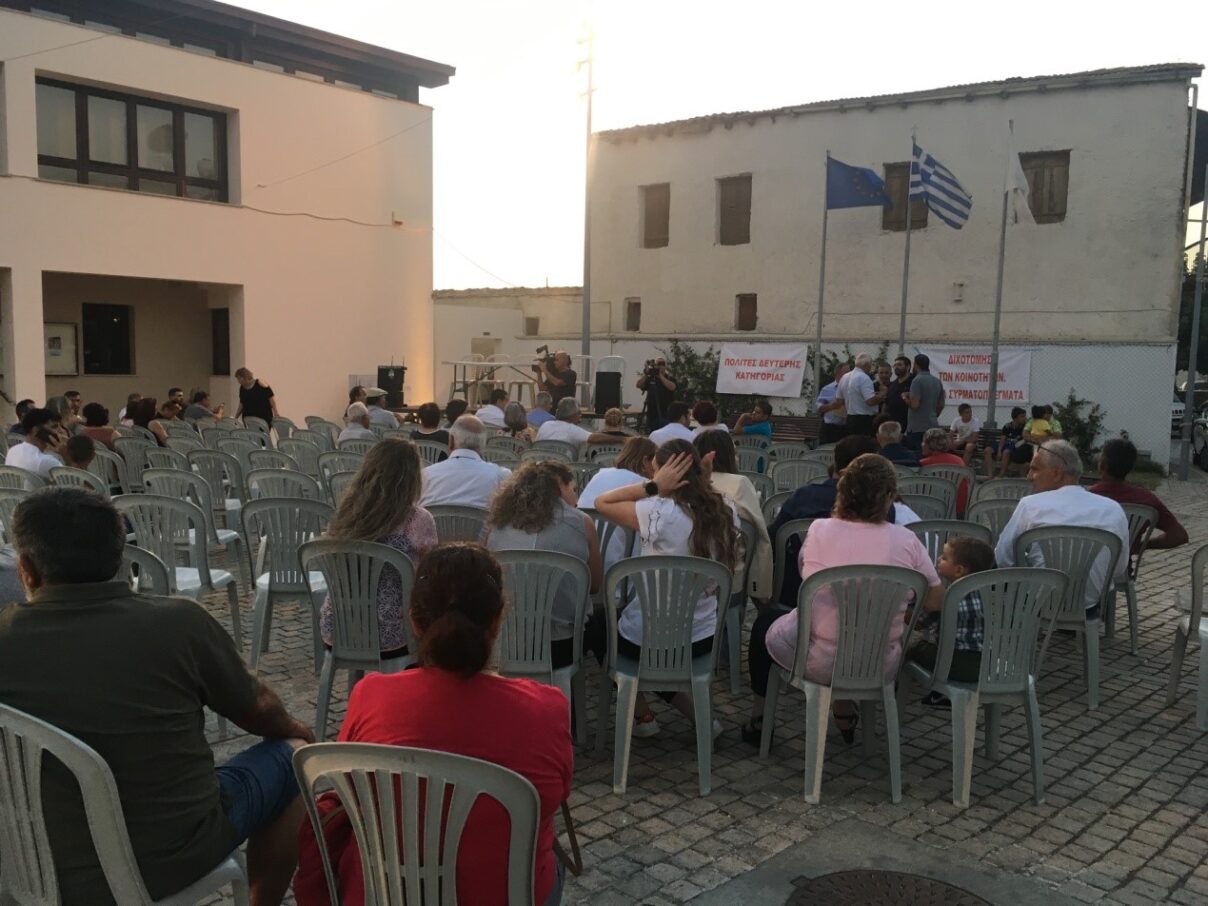 Village inhabitants of the western Nicosia area gather at Akaki square to protest against the presence of the barbed-wire fence on 29 June 2022.
Village inhabitants of the western Nicosia area gather at Akaki square to protest against the presence of the barbed-wire fence on 29 June 2022.
© Maria Kenti-Kranidioti
 The series of 30 flags representing the city of Orestiada and the 29 villages of the municipality put up by protesters demonstrating against the expansion RIC-Fylakio on 10 July 2022.
The series of 30 flags representing the city of Orestiada and the 29 villages of the municipality put up by protesters demonstrating against the expansion RIC-Fylakio on 10 July 2022.
12 November 2022 © Maria Kenti-Kranidioti
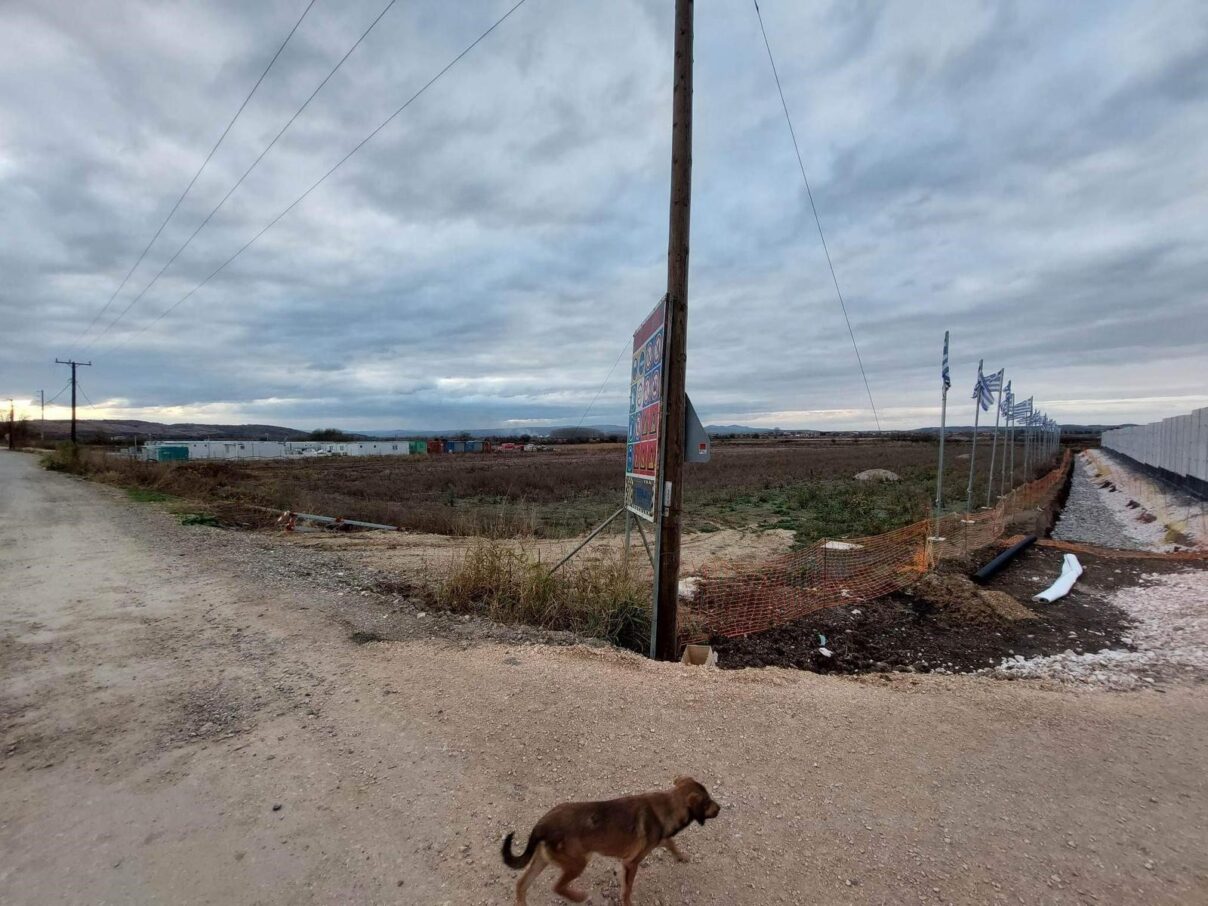 The empty lot between the expansion sites at RIC-Fylakio a local inhabitant refused to rent to the government but handed over to the Church instead.
The empty lot between the expansion sites at RIC-Fylakio a local inhabitant refused to rent to the government but handed over to the Church instead.
22 November 2022 © Maria Kenti-Kranidioti
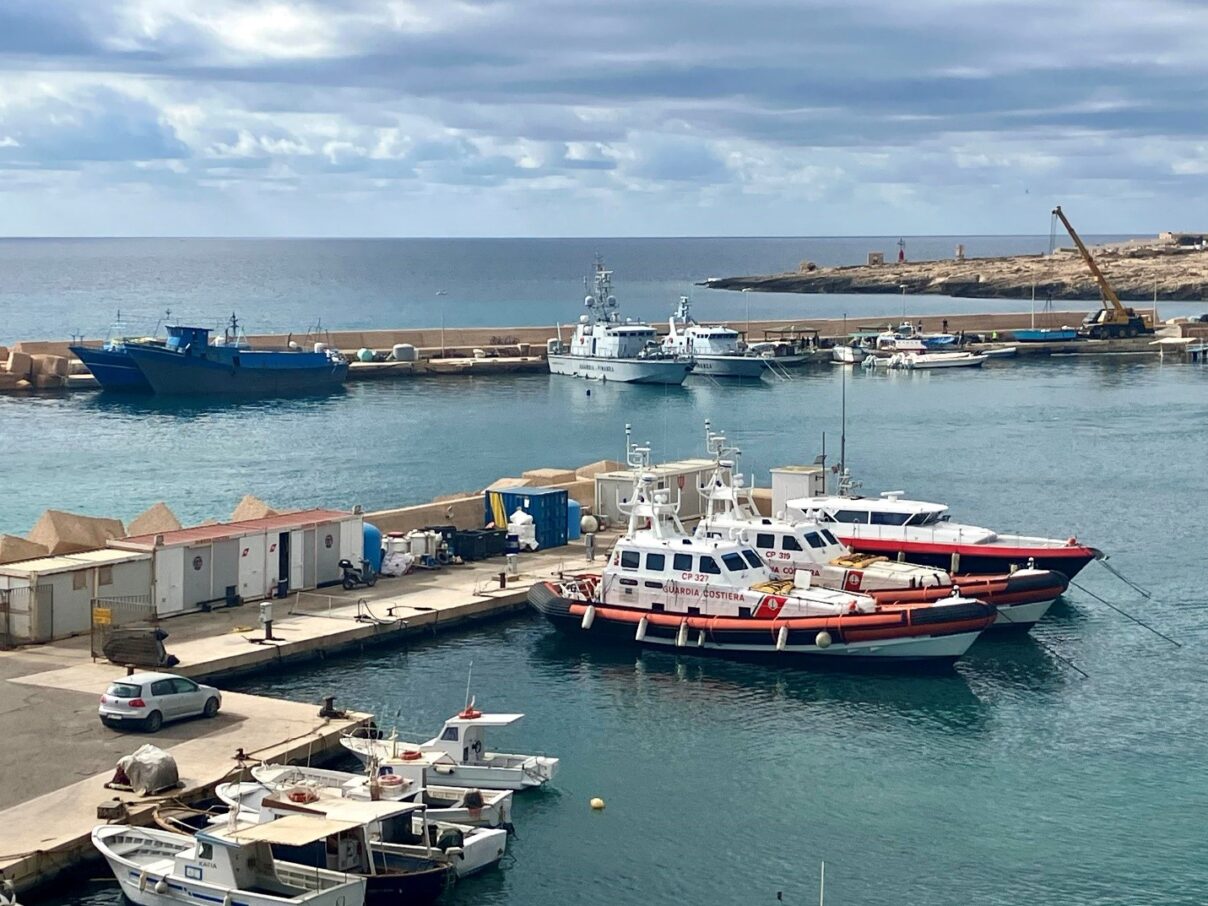 Lampedusa port © 2023 Janina Pescinski
Lampedusa port © 2023 Janina Pescinski
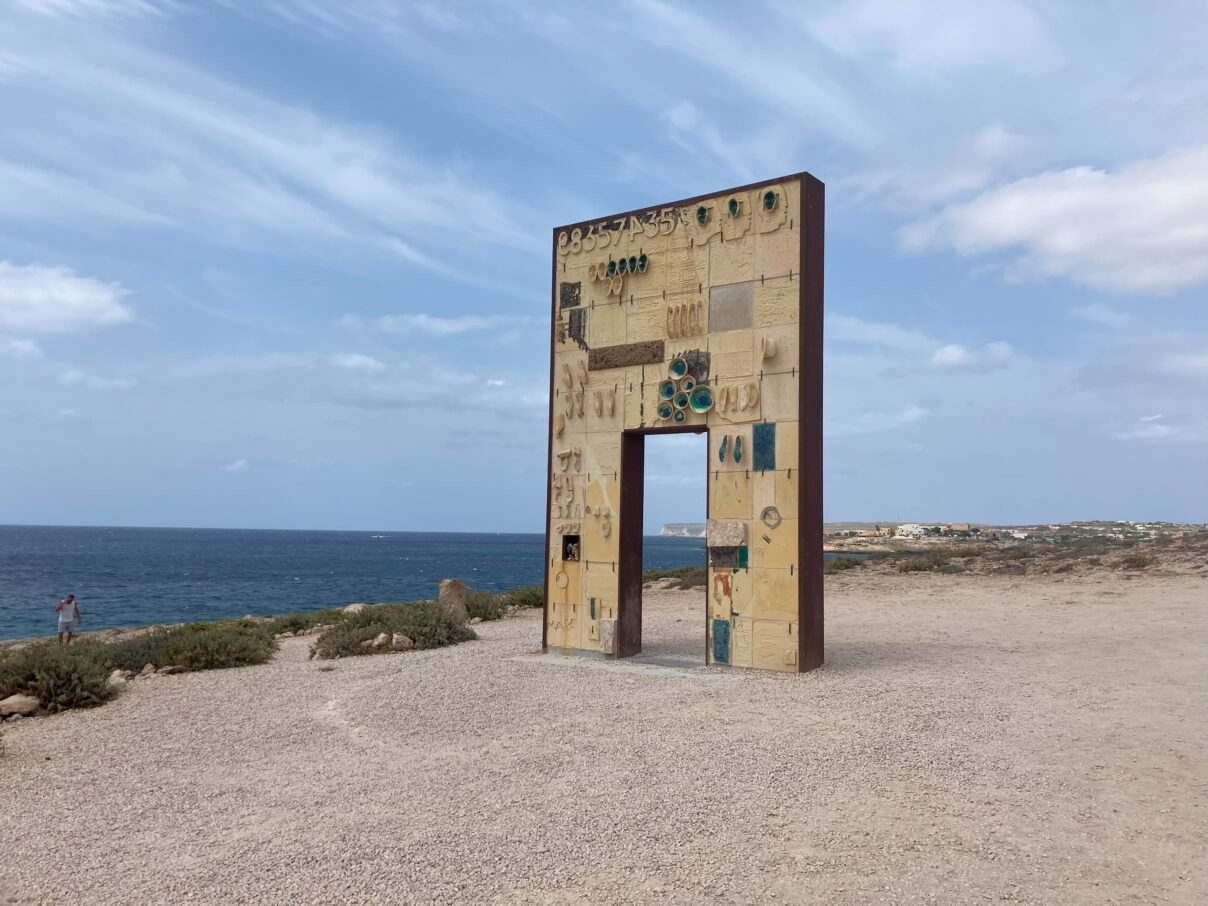 La Porte d’Europa, Lampedusa © 2023 Janina Pescinski
La Porte d’Europa, Lampedusa © 2023 Janina Pescinski
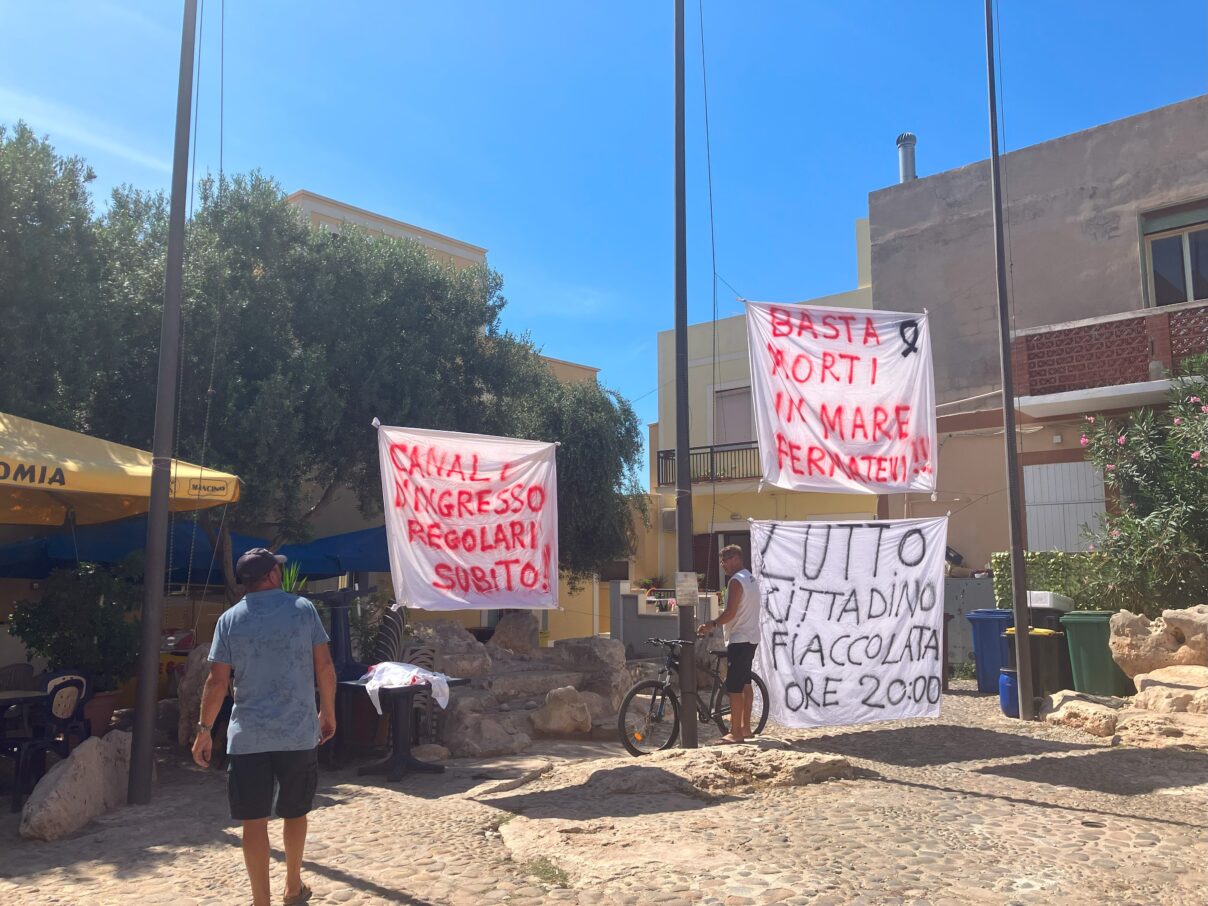 Citizen protest banners in Lampedusa © 2023 Janina Pescinski
Citizen protest banners in Lampedusa © 2023 Janina Pescinski
 Migrant boats awaiting disposal, Lampedusa © 2023 Janina Pescinski
Migrant boats awaiting disposal, Lampedusa © 2023 Janina Pescinski
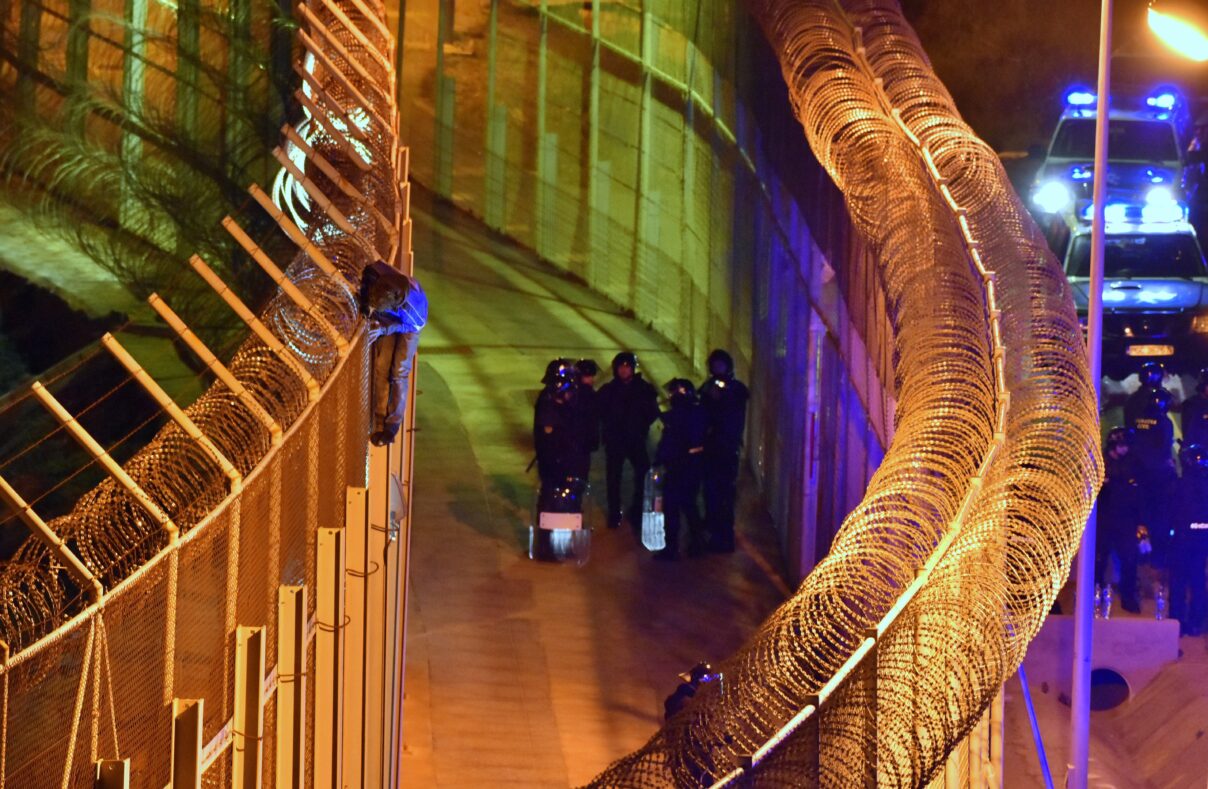 A young migrant perched on the fence in Ceuta in the early hours of New Year’s Eve 2017. He tries to enter the city but the Spanish Guardia Civil impeded his access. After 4 hours on top of the it, the young man decided to descend and was returned to Morocco. © Antonio Sempere
A young migrant perched on the fence in Ceuta in the early hours of New Year’s Eve 2017. He tries to enter the city but the Spanish Guardia Civil impeded his access. After 4 hours on top of the it, the young man decided to descend and was returned to Morocco. © Antonio Sempere
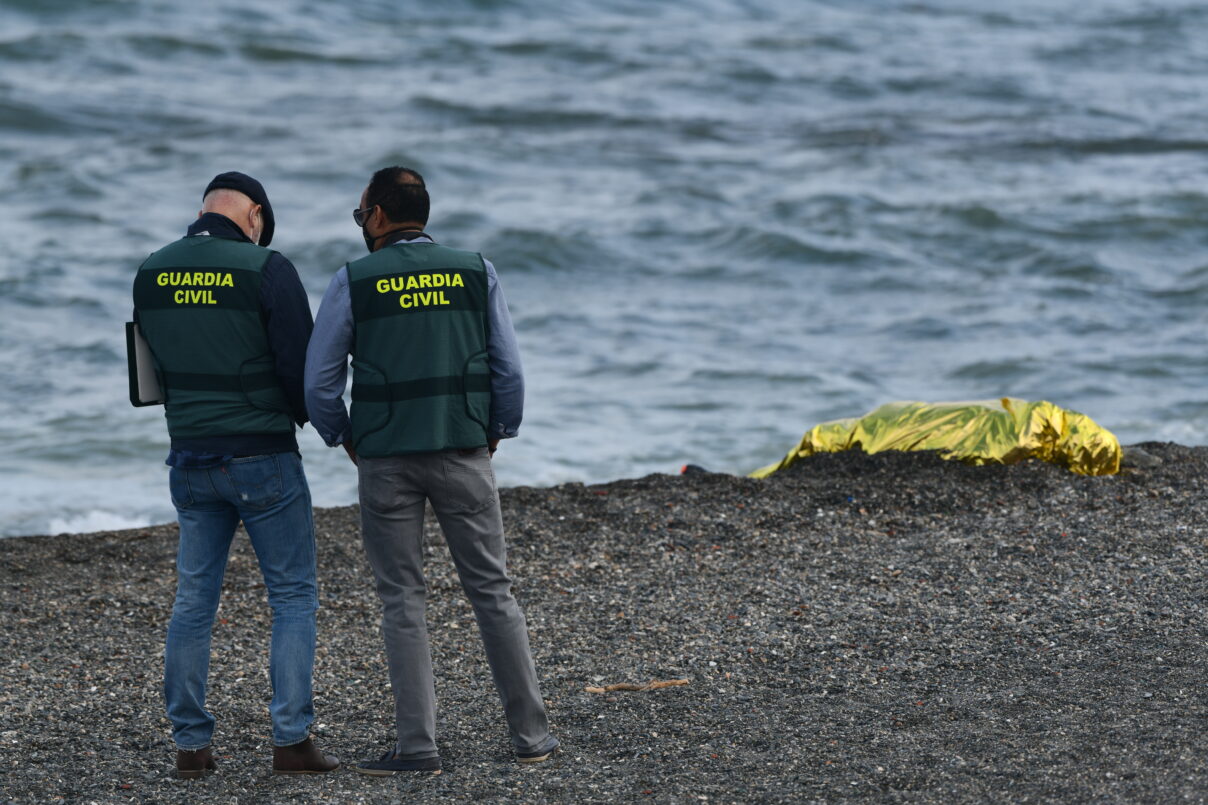 After the crossing of thousands of people on May 17 – 20, 2021, two people drowned in the attempt and their bodies were recovered from the sea by the Guardia Civil. This is the everyday reality of many people who try to swim from Morocco to Ceuta The image shows the corpse of a young Moroccan migrant on 19 May 2021. © Antonio Sempere
After the crossing of thousands of people on May 17 – 20, 2021, two people drowned in the attempt and their bodies were recovered from the sea by the Guardia Civil. This is the everyday reality of many people who try to swim from Morocco to Ceuta The image shows the corpse of a young Moroccan migrant on 19 May 2021. © Antonio Sempere
 Numerous children were forced to cross the Tarajal border into Ceuta with the complicity of the Moroccan police. The Government of the neighboring country used thousands of migrants in retaliation for the diplomatic crisis triggered by the hospitalization of the Sahrawi Polisario Front’s leader Brahim Ghali in a Spanish hospital. This image corresponds to the afternoon of 17 May 2021. © Antonio Sempere
Numerous children were forced to cross the Tarajal border into Ceuta with the complicity of the Moroccan police. The Government of the neighboring country used thousands of migrants in retaliation for the diplomatic crisis triggered by the hospitalization of the Sahrawi Polisario Front’s leader Brahim Ghali in a Spanish hospital. This image corresponds to the afternoon of 17 May 2021. © Antonio Sempere
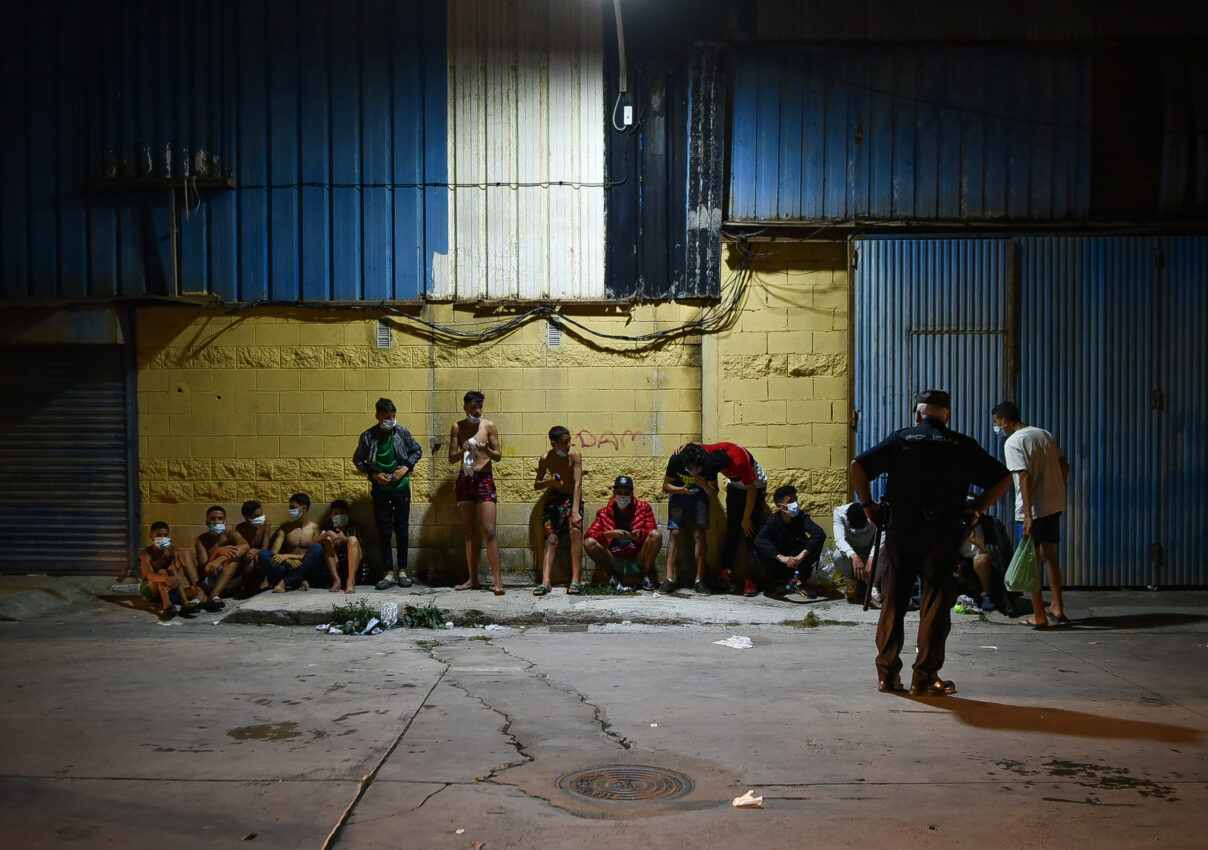 A group of unaccompanied minors held by the Spanish National Police wait to be able to enter emergency reception resources enabled in the industrial warehouses of the Tarajal border. Some of them were directly returned to Morocco during the largest humanitarian crisis experienced by the city of Ceuta in its entire history on 18 May 2021. © Antonio Sempere
A group of unaccompanied minors held by the Spanish National Police wait to be able to enter emergency reception resources enabled in the industrial warehouses of the Tarajal border. Some of them were directly returned to Morocco during the largest humanitarian crisis experienced by the city of Ceuta in its entire history on 18 May 2021. © Antonio Sempere
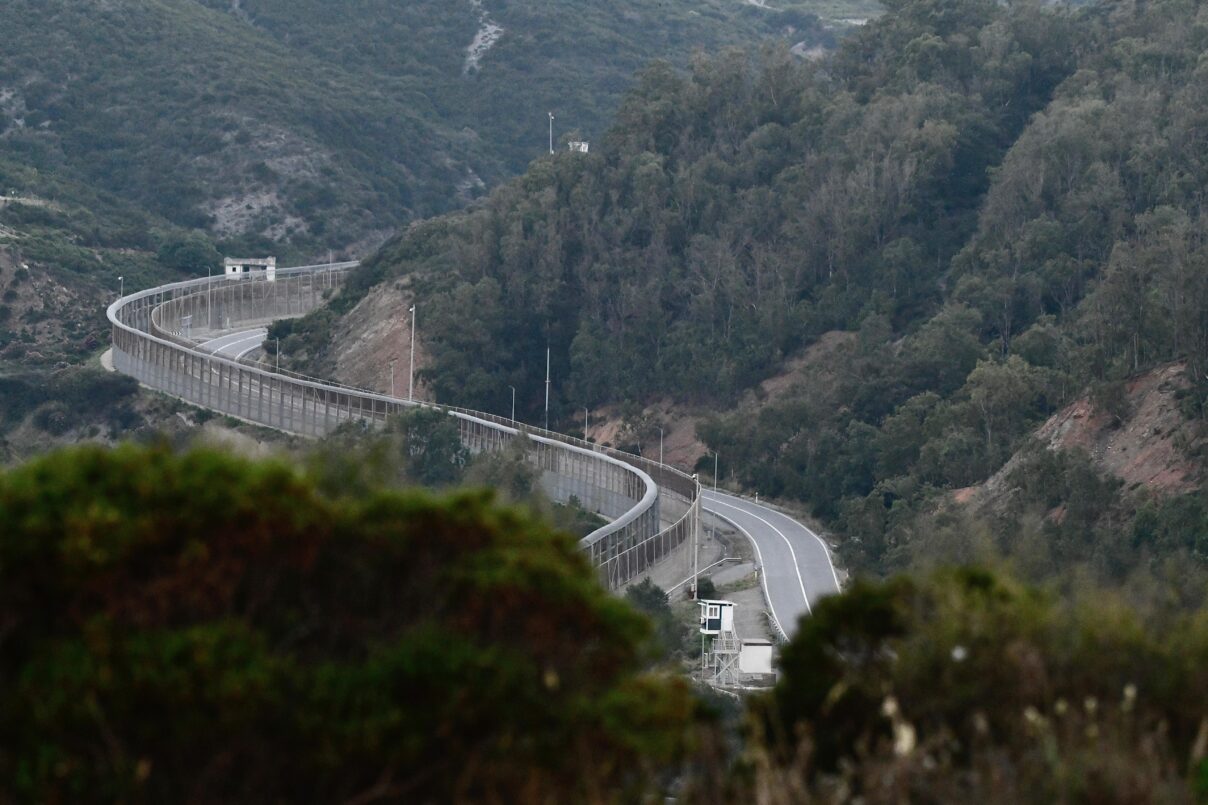 Image of the Southern Border of Europe in Ceuta. With an extension of around 8 km from north to south, the fences separate Spain from Morocco and were built to prevent the entry of migrants from sub-Saharan Africa and the Maghreb. © Antonio Sempere
Image of the Southern Border of Europe in Ceuta. With an extension of around 8 km from north to south, the fences separate Spain from Morocco and were built to prevent the entry of migrants from sub-Saharan Africa and the Maghreb. © Antonio Sempere
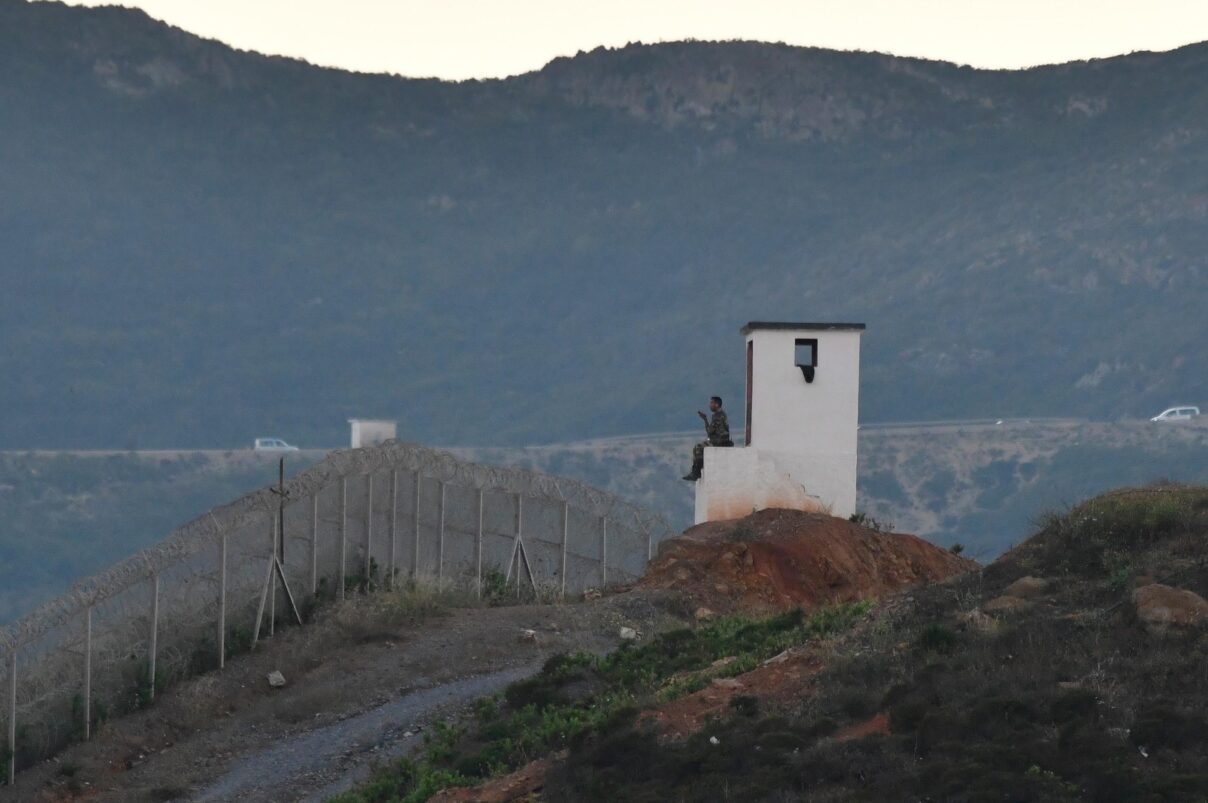 After the removal of fence’s concertina wiring in 2019, Morocco built other fences with European money, which were plagued with blades to prevent the passing of people. The Moroccan government shielded the forests near the Spanish border with units of the Royal Gendarmerie and the army. Image from June 2023. © Antonio Sempere
After the removal of fence’s concertina wiring in 2019, Morocco built other fences with European money, which were plagued with blades to prevent the passing of people. The Moroccan government shielded the forests near the Spanish border with units of the Royal Gendarmerie and the army. Image from June 2023. © Antonio Sempere
 During the migration crisis that happened in Ceuta in May 2021, the Spanish government mobilized the army to alleviate attempts to enter the Tarajal breakwater protecting the city on 19 May 2021. © Antonio Sempere
During the migration crisis that happened in Ceuta in May 2021, the Spanish government mobilized the army to alleviate attempts to enter the Tarajal breakwater protecting the city on 19 May 2021. © Antonio Sempere
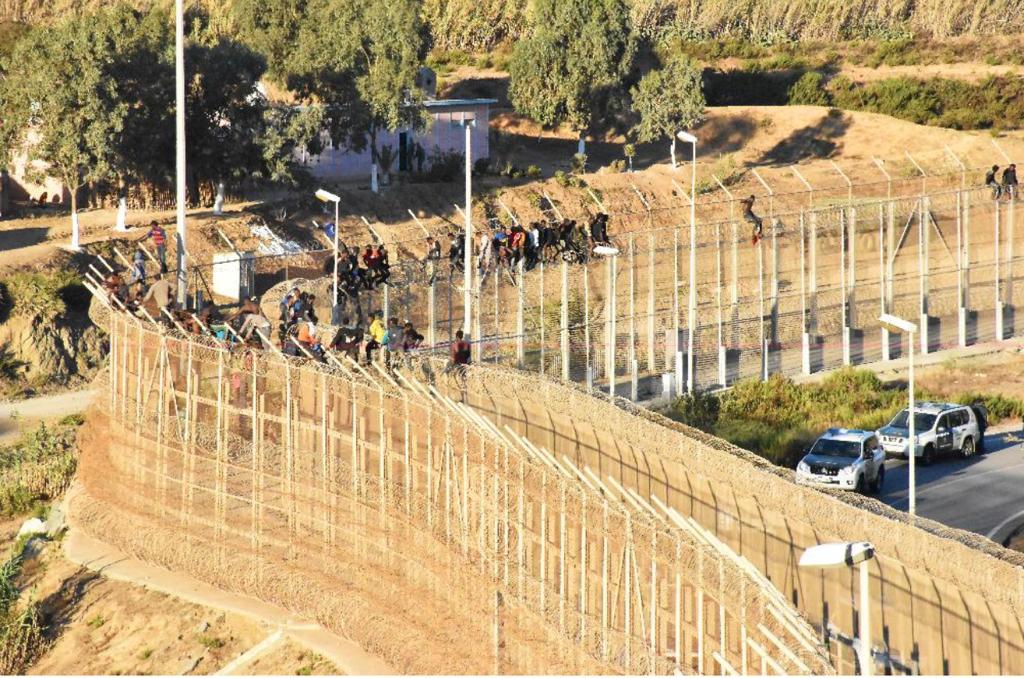 On 16 September 2016, more than 200 migrants tried to jump the fence that separates Morocco’s border with Europe in Ceuta. During the jump, both Spanish and Moroccan security forces prevented them from entering Spain, proving how cooperation with Morocco managed to get the Moroccan gendarmes to enter Spanish territory to conduct push-backs. Something similar happened again on 17 November 2023 with 1,000 people attempting to cross the fences. © Antonio Sempere
On 16 September 2016, more than 200 migrants tried to jump the fence that separates Morocco’s border with Europe in Ceuta. During the jump, both Spanish and Moroccan security forces prevented them from entering Spain, proving how cooperation with Morocco managed to get the Moroccan gendarmes to enter Spanish territory to conduct push-backs. Something similar happened again on 17 November 2023 with 1,000 people attempting to cross the fences. © Antonio Sempere
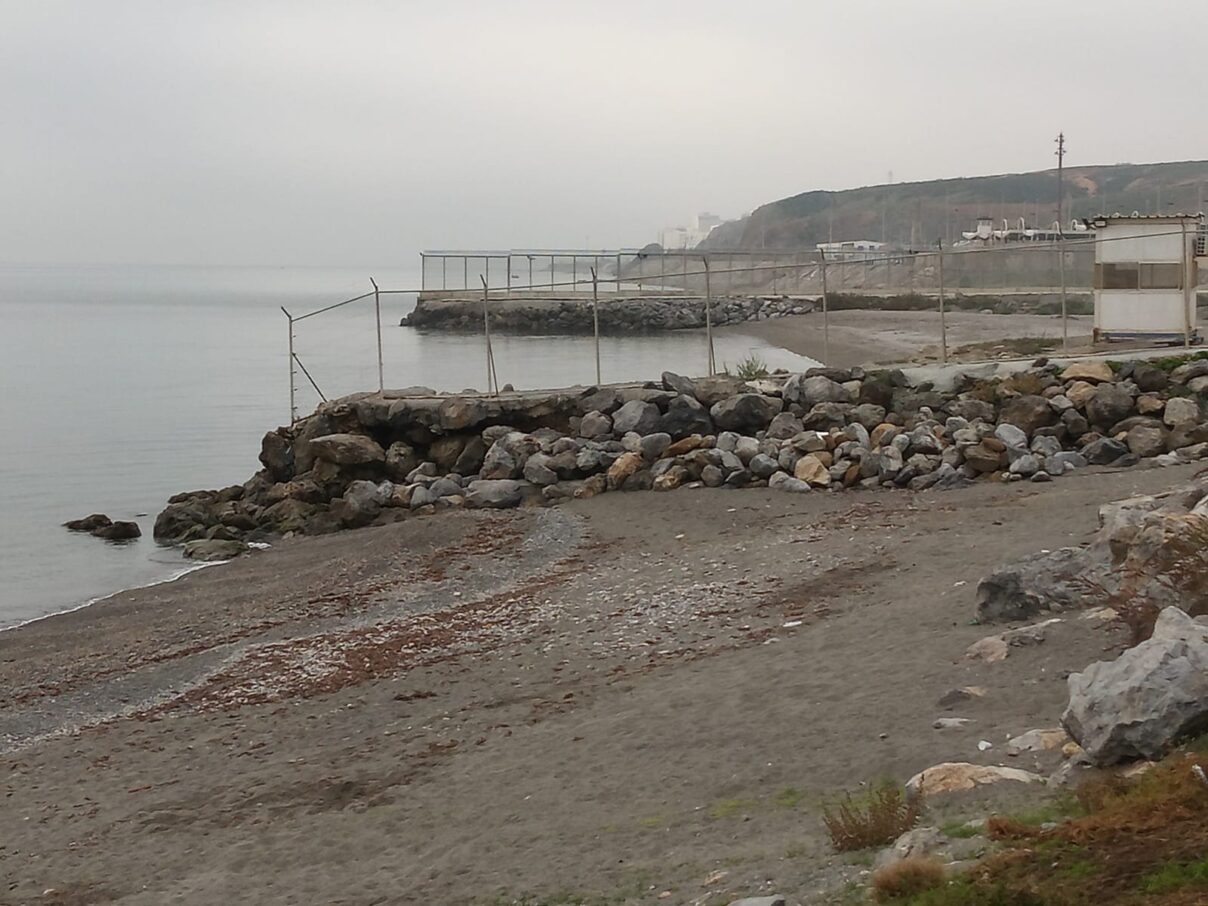 Spanish and Moroccan fences protecting the city by the sea side on the Tarajal border, which is the only open border for people to cross regularly. © Bernardo López Marín
Spanish and Moroccan fences protecting the city by the sea side on the Tarajal border, which is the only open border for people to cross regularly. © Bernardo López Marín
 The border-fence separating Ceuta and Morocco at the village of Benzú. Fences surrounding Ceuta are securitized by satellite systems and thermal radars that detect human movement close to them and also in the sea. © Bernardo López Marín
The border-fence separating Ceuta and Morocco at the village of Benzú. Fences surrounding Ceuta are securitized by satellite systems and thermal radars that detect human movement close to them and also in the sea. © Bernardo López Marín
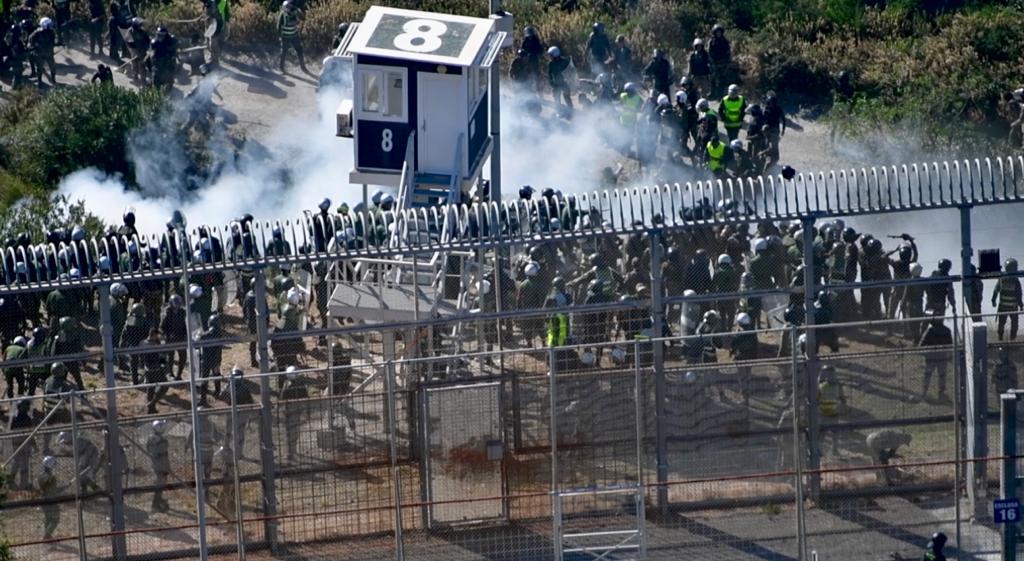 Another jump attempt happened again on 17 November 2023 with 1,000 people attempting to trespass the fences. There were people injured and a heavy presence of government forces were disposed to site. This event is now being used as an argument for the right wing to legitimate ‘invasion’ discourses and criticize border management of current government in Spain. © Antonio Sempere
Another jump attempt happened again on 17 November 2023 with 1,000 people attempting to trespass the fences. There were people injured and a heavy presence of government forces were disposed to site. This event is now being used as an argument for the right wing to legitimate ‘invasion’ discourses and criticize border management of current government in Spain. © Antonio Sempere
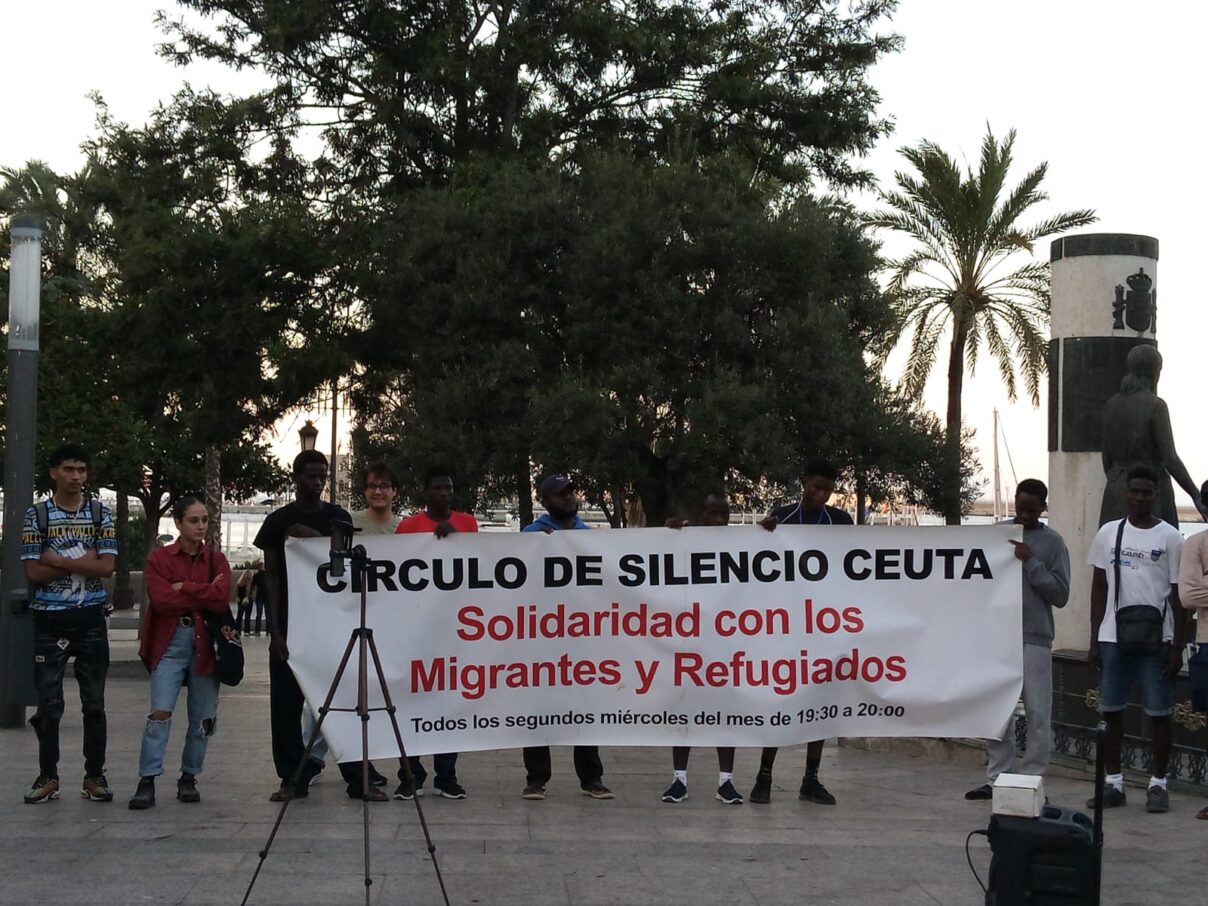 The association Elin arranges a Circle of Silence the second Wednesday of every month to recall the memory of migrants and publicly denounce injustices and the violation of human rights giving a month’s statement, followed by a manifesto. © Bernardo López Marin
The association Elin arranges a Circle of Silence the second Wednesday of every month to recall the memory of migrants and publicly denounce injustices and the violation of human rights giving a month’s statement, followed by a manifesto. © Bernardo López Marin



































